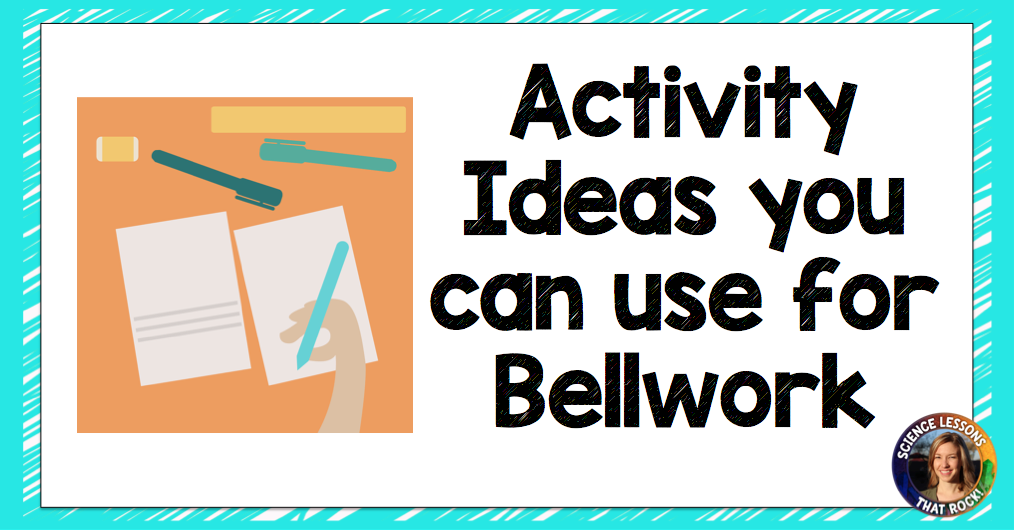Bell work… Bell ringers… Do-nows… Warm ups. Whatever you call them, it is important to have some sort of routine at the beginning of the class period. Your day will run so much smoother when students walk into class and know what to begin working on without being told.
I love using daily bell work assignments because:
- It allows me a few minutes to sit and take attendance,
- Keeps students from congregating around your desk (middle school teachers understand this!),
- Gives classroom structure to your SPED/ADHD students,
- Easy grading (without giving a “participation” grade),
- Reminds students of what we previously learned or gets them thinking about a new concept.
Here are some ideas on what you can use for bellwork.
Some teachers like to do the same type of bellwork every day and others like to vary it Monday-Friday. Do what works for you!
- Questions from previous class period: This is my go-to. I have a blank template form that I give students every Monday and they turn in every Friday. On the board I give students a question that is something we discussed the previous class periods. They can use their notes if necessary and I go around and stamp for completion after a few minutes have passed.
- Writing prompts: If you want to work on students’ writing skills (which they always need) try using writing prompts. I like to use them before a new concept is taught to get students thinking and we can discuss to identify any misconceptions. If you would like to check out some science writing prompts, click here.
- Motivational Monday: Find a motivational video clip or quote and do a motivational Monday bellwork activity. Some days we all could use a pick-me-up!
- Fake news Friday: In a world full of fake news, it’s good to have students practice looking at information with a critical eye and identifying if the source is legitimate or not. Show students an article, website, video, or image, and ask them to discuss if they think it is real or not. (A great example is this hydrophobic shoes video clip).
- CER practice: If you are utilizing the CER method in your classroom, it is always good to practice. I find students really need practice with the reasoning section. A fun way to review is to show a short video clip and have students identify the claim and any evidence in the clip. Check out this blog post for some video clip ideas!
- Brain teaser: A quick google search will pull up fun brain teasers you can do with students. These are a fun activity that you can use on Fridays.
- Show a comic strip: I had a chemistry professor in college that would begin every class with a comic strip under the document camera. It wasn’t necessarily science related but was a stress-free way to begin class and include some humor. His favorite was Calvin and Hobbes!
- Cornell note summaries: If you have students take Cornell notes, filling out the summary section is another great way to refresh their memory of what was learned the previous class period. Randomly call on 1 or 2 students to read their summaries out loud to see if they understood the material.
- Graphing practice: Want to work in some graphing practice? Check out graphingstories.org. They have 15 second video clips that students watch and then create a graph from.
- Famous scientist highlight: Highlight a famous scientist each week and have students learn about their contribution. You can find posters of famous scientists here.
- Brain Break: After a full day of classes, some students just need a quick brain break. Check out this blog post with a list of brain break ideas for secondary students.
- Old state test questions: Testing season coming up? Most states offer practice questions students can review. I tend to do around 3 a day the week or two before testing begins.
- Quizlet: Want to review vocabulary from the unit? Have students do a quick review using quizlet.
- 60 second science podcast: Most podcast episodes are LONG, but check out “60 second science” podcast from Scientific American. (Want more science podcast ideas? Click here).
Grading:
How you decide to grade bellwork is completely up to you (and will depend on the activity). I tend to stamp for completion each day, turn in on Fridays, and add up the stamps for credit. It’s easy points- all students have to do is show up and give effort. Whatever method you choose- don’t create a bunch of work for yourself. You have enough to grade without the added stress of bellwork.
I hope you find a few of those ideas useful!
Rock on,








